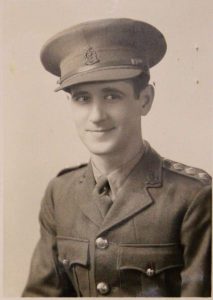
| Rank | Captain, Major (OBE) |
| Unit # | Kent Regiment, Royal Canadian Army Medical Corps. - Atlantic Command |
| Resident | 374 King St., West., Chatham |

Born in Sugar City, Colorado 6/11/1907. The son of Harold Emile and Ethel Elsie Foex and brother of Helen. The family moved to Chatham when Harold was very young.
In Chatham he attended Central Public School and the Chatham Collegiate Institute. A graduate of the University of Toronto in 1932, as MD and L.M.C.C. He interned in Detroit Michigan and at the Banting Institute in Toronto. He trained as a surgeon in Toronto and in Oxford, England where he met his future wife Phyllis Marjorie (nee Graves-Morris) in September of 1938.
They had three daughters Judith, Caroline and Elizabeth. Dr. Foex setup his practice in Chatham for four years prior to the outbreak of war.
Served with the Kent Regiment.
It was reported that recruits to the Kent Regt. in Chatham would receive their preliminary medicals by Lieut. Barlow and Lieut. H. E. Foex when recruiting begins in 1939. CDN 8/09/39.
Captain Foex was the first medical officer of the 1st Battalion Kent Regiment, enlisting with the Regiment in 1940.
Dr. Foex then went to Chorley Park Military hospital in Toronto and from there to Labrador with the R.C.A.M.C. It was reported in the CDN 9/11/42 and 12/11/42(P), that Major Foex who had been stationed in Newfoundland arrived in Chatham on a two week leave to see his wife and little daughter as well as his mother. In 1942 he was stationed at Chorley Park, Toronto, ON. as second in command of surgery. From there he went across the Atlantic in 16 April, 1943 with No. 2 Canadian General Hospital. But before he went overseas he his mother and his wife went to Ottawa to see him invested as a member of the most Excellent Order of the British Empire by the Governor General at Government House. While at Bramshot, England he treated casualties from the D-Day invasion of Normandy, France for two months before going to the continent. He took a surgical team up to the front at Caen then moving to Liseux, Bolounge and Antwerp as the Canadian Army advanced.
In May of 1942 he was stationed in Newfoundland, where he received his Majority. Major Foex would come out of the line in December of 1944 returning to No. 2 General Hospital then located at Ghent, Belgium. He and his wife were living at 372 King St. West, Chatham, ON.
The Major treated many “V-Bomb” casualties while he was stationed in Antwerp. Dr. Foex said they were about the same as those caused by any high explosive. “People just went about their everyday business, despite the V-Bombs. They were taken as a matter of course.” Major Foex would come out of the line in December of 1944 returning to No. 2 General Hospital then located at Ghent, Belgium. He and his wife were living at 372 King St. West, Chatham, ON. Reported returning to Canada aboard the hospital ship Letitia, expected to arrive at Halifax, on the 12thof August, 1945. CDN 10/08/45.
Reported returning to Canada aboard the hospital ship Letitia, expected to arrive at Halifax, on the 12th of August, 1945. CDN 10/08/45. In an interview with the CDN 18/08/45, Major Foex discuss the advances that had come about in the treatment of casualties during the Second World War, one the “Trueta treatment”, which actually came out of the Spanish Civil War. A method of treating serious wounds by leaving them open and putting a plaster cast around them. Developed by a Spanish Dr. Trueta, “Very little infection of wounds occurs using this technique.” the Major reported. “Shell casualties were always the worst,” he stated. We got them at the beginning of an attack. Casualties from mortar and bullets came later.”
No. 2 General Hospital was one of the first to use penicillin and had a few months practice the new discovery before D-Day. Plasma came from blood donated in Canada and Blood Clinics while whole blood was flown in daily from England. Sometimes we used half blood an half plasma, or either. Major Foex contributes the use of blood plasma and whole blood as having the greatest effect in reducing fatalities during WWII. “We just couldn’t have worked without plasma and whole blood.”
The use of blood and plasma administered at the front lines and continued until the casualty reached a surgical unit save many lives. “Average cases required two quarts of blood or plasma or four time the average single donation”. Concerning the evacuation of the wounded the Major reported that “it was very good with many cases being flown back to England inside of ten days.” CDN 20/08/45
He was mentioned in the King’s New Year List and was awarded the Order of the British Empire (O.B.E.) Was sent to England September 1943 and served in France, Belgium and Holland.
Discharged October 10th, 1945.
After the war Dr. Foex resumed his practice in Chatham until 1967. He passed away 2/05/1968.
ADDITIONAL INFORMATION
| Sources | KCFA, IODE(P), CCI-RH, CDN (8/09/39 (enlists)), CDN (10/08/45 (returns)), NB(N), C-KPT (A. Fisher) |
| Birthplace | Sugar City, Colorado |
| Religion | Presbyterian |
| Marital Status | Married |
| When Enlisted | August 9th, 1940 |
| Next of Kin | Wife- Mrs. Phyllis Marjorie Foex |
Notice something wrong with this record? Or, do you have something to add? Report it using our online form.


